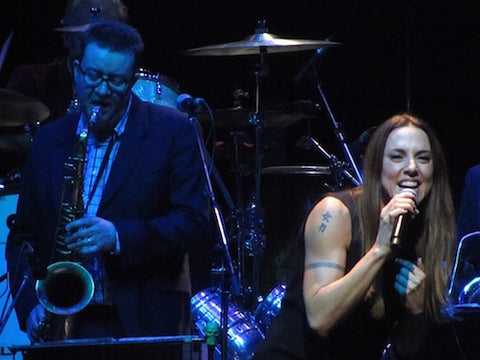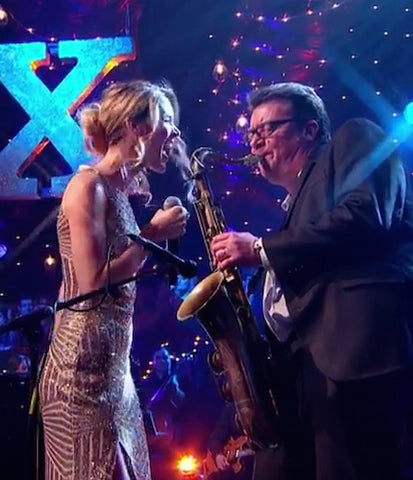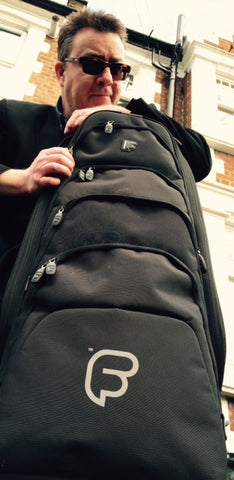Phil Veacock is best known for his work as tenor saxophonist and musical arranger in Jools Holland's Rhythm and Blues Orchestra, a position he’s had for over 21 years.
If you’ve seen the band live, or on the BBC’s ‘Later With Jools Holland’ or indeed, on the channels annual New Year’s Eve Hootenanny, he’s the one centre stage, giving subtle cues to the rest of the band whilst still playing the sax, what a guy.

We seem to surprise Phil when we call for the interview.
“Sorry, I’m a bit late and not quite ready,” he gushes.” I’ll have to put you on speaker phone for a while, and if you hear panting, it’s ok, I’m in the middle of kneading organic dough. Don’t worry I’ll explain. A while ago my good friend Simon Macer- Wright and myself decided we liked fresh bread so much, we went on a bread making course together. The word got out that we were serious home bread makers and were soon producing far too much bread our families and friends could eat. When we took our kids to school in the morning and picked them up in the evening, we sold bread to parents. Even with the kids and the mums and dads taking all they could, we were still all doughed up with surplus, so we decided to launch Book Bag Bakers, and we now supply local bakers, coffee shops, cafes and grocery stores, with Simon specialising in sourdough, while I bake traditional yeasted loaves.
You can also go on the site and order your favourite loaf, which is really cool, I’m enjoying it and I’ve found another job that pays even less than playing the saxophone for a living, maybe we should talk about that now.”
Phil is without doubt an extremely talented musician and musical arranger, with a CV as long as the Magna Carta, but what made him first go down the brass instrument road.
“Ah, I have to trip you up there, let’s just go back to basics. Whilst there is a lot of brass involved in the construction, the saxophone is actually a woodwind instrument, as it has a single reed like a clarinet.
If we go back to around 1846, it was a Mr Adolph Sax who played a woodwind instrument in a marching band, and noticed that the trumpets and trombones were overpowering the woodwind instruments, so he decided to make a woodwind instrument out of brass, and was very successful, as here I am playing an Alto Sax.
I started out as a kid playing the recorder and I have to say, I was pretty good, a virtuoso even. At school concerts and assemblies I was set apart from the orchestra and stood alone handling the solo spots and playing hymns. I loved this and it fed my natural showing-offness’ and like being ‘up there’ which I still do to this day as an entertainer.
Thanks to my parents, I upgraded to a clarinet and I had lessons with a guy called Bill Watson who was in the RAF Central band that gigged at local dances. I noticed during the lessons that people would phone up to book the band and I heard what he was charging. I thought I would like to be in that band and earn lots of money. Bill got me into a local wind band, a bit like an American high school band which I enjoyed. Then I upgraded once more to a position playing in orchestras. I loved it, but I noticed on the BBC’s Top Of The Pops programme, there weren’t any clarinet players, the bands had a brass section and the clarinet didn’t seem that cool. Bill found me a saxophone and because I could already play the clarinet, I found it so easy to play the sax.”

Who were your influences for this instrument as a youngster?
“There were so many great saxophone players I listened to when I was kid, a lot of my peers liked the flashy players, the great Michael Brecker for example, but I was more into the older material played by the likes of the much loved Dexter Gordon the American Tenor Sax player, he’s the tops in my eyes. I was also a massive soul music fan, I loved Junior Walker, and King Curtis and all those honkers and screamers like Wilbert Lee Diamond sax player in Little Richard’s band. Some of the 70’s pop songs had some fantastic sax sounds, Mott The Hoople’s All The Way To Memphis for example. I must have been about 17 when Madness released ‘One Step Beyond’ which I picked up instantly and suddenly I was in demand with bands wanting a sax player.
I was in a school band called The Wowdy Webels playing covers by The Rolling Stones and The Beatles and we went down really well. I also had the voice of an angel and was chorister at Holy Trinity Church Haselmere, studying music and playing in orchestras, so I was into classical material as well as running parallel with the rock band. Like a lot of musicians, in my last years at college I went to parties and, as a consequence, I didn’t do that well at exams, so I went to Christ Church College in Canterbury. They had started a new course in film, TV and music, a joint honours degree.
I loved it and had a great time and met fantastic friends. We formed a band called The Larks, which had two unusually matched people with distinctive, disparate musical tastes, one liked The Ramones and the other James Brown. Even though it was a collision of styles, it worked really well and we were quite successful with our own record company, appearing on radio and TV shows and with singles in the charts.
The inevitable split came after a while and I used my degree to work in the film business whilst also depting in a band in Deptford called the Deptford Dance Orchestra, this was a crazy band put together by Roger Gosling who is still in Jools Holland’s band today with me and Paul Bartholomew. At the time, Ronnie Burrow who was the sound engineer brought Jools along to see this mad band. He’d just left Squeeze and asked if I’d play sax on his next single.
We went to his studio to play the Maidens Lament, I did a little solo, after that Jools was going on Terry Wogan’s show and asked us to play on Holy Cow live, and before we knew it we were a regular feature. This was about1989.”
You are an incredibly busy musician with solo projects as well as TV, Radio and touring with the Rhythm and Blues Orchestra. Do you still have time for session work, and do you regard yourself as a session player?
“Well, I’ve never really been a session player. In the old days a session player would move from one studio to another day after day, but it’s all changed so much there aren’t that many opportunities these days for session work, it hardly exists now. I’m far too busy working with my own band, a trio called The Deptford Rivieras and with the Rhythm and Blues Orchestra which is like one big family unit of talented musicians, we rehearse, gig and live together on tour. We all pile in hotels and aeroplanes. I remember I arrived early to an airline check-in desk with Jools, and he commented on the huge queue in front of us, then you realise there’s hardly anyone there really, the queue is the band.”
The BBC programme ‘Later With Jools Holland’ has a massive fan base, with new and established artists playing live, often with the Rhythm and Blues Orchestra, how long do you have to rehearse the songs for a particular show?
“Not long, especially on the radio show, where a guest might arrive near show time and we still haven’t been told what the songs are that they want us to play, that can be a bit ‘seat of your pants’. For the annual New Year’s Eve Hootenanny TV shows, the band has just one rehearsal, where I also have to do quite a lot of the arranging, which I really like, there are other very competent arrangers in the band I must add.
The role of an arranger in Jools’s band can be quite tricky as some players, whilst they are incredibly talented, they don’t actually read music, so I have to take this into consideration and make sure the brass and saxophone parts are adaptable enough to allow for changes within the feel or tempo of the song. These arrangements can be very organic, and with my geographical position in the middle, and front of the stage, I can give cues to the band.
I can arrange songs pretty quickly, which is handy as time is always tight. I’ve often had to work on songs not only for the band but also for a large string section of symphony orchestra players, where Jools has asked me to arrange all the parts to fit the song during a ten minute break, this can be pretty nerve racking.”
You always manage to capture a rich, warm sound for radio, TV and the band’s albums. Many of the old classic soul records from the 60’s, were recorded in one take, with just a few microphones placed around the studio, with the instrument ‘overspill’ bleeding into the next microphone adding to the chemistry.
“Yes, that’s correct, and rather than having us all in separate booths, Jools will record us in one room as he so rightly says, you get a better live feel which you can hear on our albums, Sirens Of Song is a good example.”

“Do you know, you are probably correct. My good friend and bass player in the band Dave Swift, did attempt to list them all on his web site, I think he’s still adding all the time. There are in fact a couple of heroes of mine I still would like to perform with, Elvis Costello and Stevie Wonder would great, we still haven’t had them in the studio.
There have certainly been some memorable moments. I played the saxophone solo on Lady Madonna when Sir Paul McCartney was on Later With Jools Holland, which was an honour. The Beatles were originally against having brass or woodwind instruments on their records. Very few were heard and I believe I’m correct in saying that the saxophone on Lady Madonna was the only saxophone solo in the whole of The Beatles output, and originally played by Ronnie Scott.”
Why do you think that the saxophone has maintained longevity and survived all the musical trends along the way?
“I think it’s because it has a timbre that is very much like the human voice, for the player it can be such an expressive and delicate instrument. On that note, I must mention my Fusion Tenor Saxophone gig bag, which I’m really enjoying. They’re light, strong and the numerous pockets for accessories are ideal, I can easily accommodate music stands and scores. They are designed with the commuting musician in mind, and if you carry it back pack style, you are totally hands free. Meantime, I need my hands, the oven is bleeping and the dough has risen.
For more information on Phil Veacock visit: www.philveacock.com
For more information on Phil’s bread making visit: www.bookbagbakers.com
